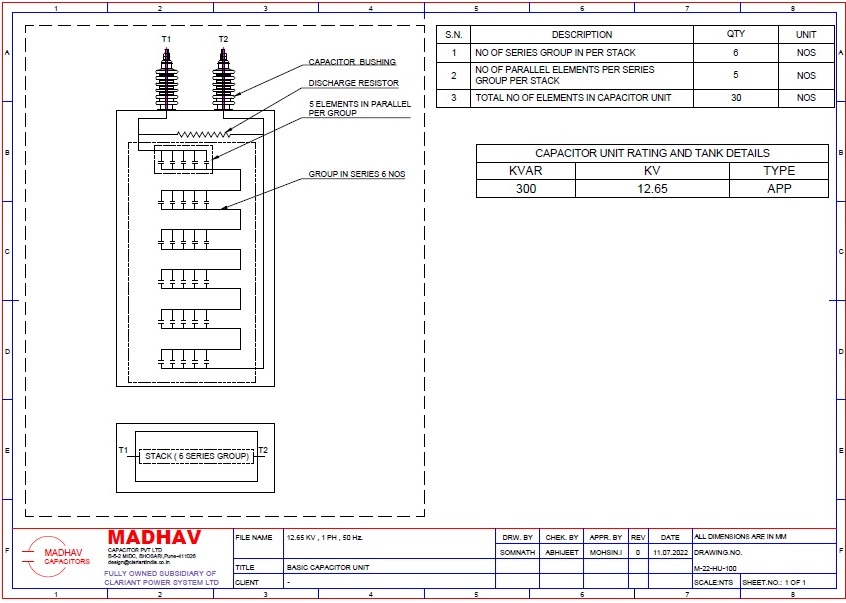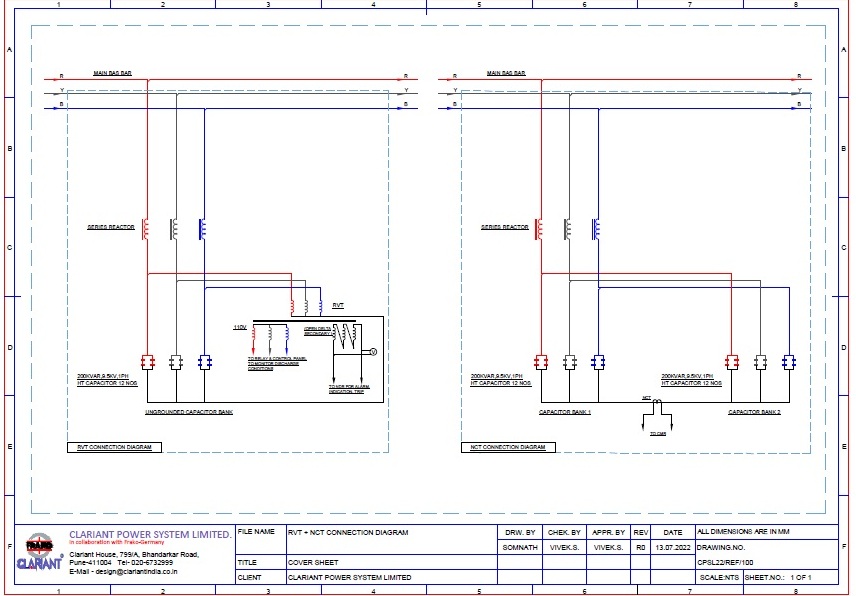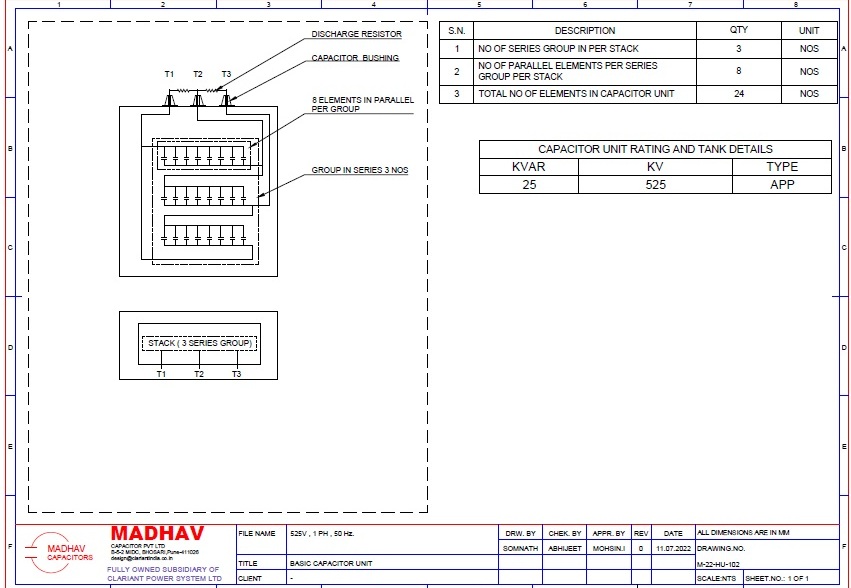Unbalance in MV/HV shunt capacitor banks can cause capacitor failures accompanied by fire and explosion
- July 20, 2022
In this article, Baldev Raj Narang investigates into the issue of unbalance protection for medium and high voltage shunt capacitor banks.
Why is unbalance capacitor protection for MV capacitor banks critical?
It is important to understand the criticality of unbalance protection for medium and high voltage Shunt Capacitor Banks. The instances of fire and accidents are not uncommon in these capacitor installations. The absence or faulty operation of this protection can cause major accidents accompanied by explosion and fire, putting installation and human safety at risk. Thus, medium, and high voltage shunt capacitor banks are provided with unbalance protection. There are two common ways of configuring this protection. RVT (Residual Voltage Transformer) with Neutral Displacement Relay (NDR) with an open delta winding to sense unbalance or Double Star connected Capacitor banks with NCT (Neutral Current Transformer) connected between neutrals of two star connected capacitor banks. Unbalance current is sensed by NCT.
Unbalance leads to cascading overvoltage phenomena
The internal construction of an APP type MV capacitor unit having series- parallel configuration of internal capacitor elements is shown in figure 1. If any element fails, a short circuit gets created across failed element and the voltage across remaining healthy elements rises. The unbalance condition starts when an internally connected individual capacitor element fails for any reason like manufacturing defect or while handling inrush current, or harmonic current, or towards end of the service life of capacitor. The onset of unbalance is a dangerous occurrence. APP capacitors have short circuit mode of failure which is unsafe. The full terminal voltage now gets applied across fewer healthy elements. This leads to failure of more capacitor elements. This is a cascading process and the healthy capacitor elements progressively experience higher and higher voltage across lesser and lesser capacitor elements. If the unbalance is not arrested the voltage rise can lead to an accident like explosion and possibly a fire.(See Figure 1)

RVT and NCT protection schemes for unbalance protection
The online monitoring of unbalance condition is necessary to isolate the faulty capacitor bank once unacceptable unbalance level reaches. The capacitors are designed to withstand 10% over voltage. Thus, unbalance above 10% is an abnormal condition. Manufacturing tolerances and system unbalance also add to capacitor current unbalance;thus, these are to be accounted for while making alarm and trip settings. Figure 2 shows unbalance protection schemes for MV/HV capacitor banks, one using RVT and another using NCT. Any unbalance in the capacitor current shifts the neutral and causes a residual voltage across the open delta winding of the RVT. This voltage across open delta winding is used to operate NDR for isolating the faulty capacitor bank. RVT can be given for each capacitor bank or common RVT for entire capacitor installation. The capacitors also discharge through RVT during normal switching operations. A tertiary winding of RVT can be used to check the discharge condition and discharge time of the capacitor bank. Similarly, a double star connected capacitor installation with NCT connected between neutrals of two star connected banks in neutral circuit monitors the unbalance current. When all capacitor units are healthy there is no unbalance in capacitor currents of three phases and thus there is no current through the NCT. Failure of one or more capacitor elements within a capacitor unit in either of the star connected banks disturbs the balance and a fault current proportional to the intensity of failure passes through NCT. This unbalance current in the NCT secondary circuit is used to activate current relay to isolate the faulty capacitor bank. The unbalance condition can also occur when external capacitor fuses of one or more capacitor units operate. This occurrence is outside the capacitor unit. It is an open circuit fault condition and does not have cascading overvoltage effect to cause further failures. Nevertheless, the unbalance protection will operate to isolate the faulty capacitor bank which can be restarted after ascertaining the cause of fuse failure.
RVT protection is sensitive to system unbalance. NCT protection is not sensitive to system unbalance or to presence of zero sequence harmonic currents. Zero sequence harmonic currents are in all legs, and their net impact on neutral current which activates unbalance protection is nil. (See Figure2)

Some practical observations and recommendations
It is observed that some MV/HV capacitor installations rely only on fuses and avoid unbalance protection to save on cost of breaker, RVT and NDR etc. Many times, the back-end breaker used is common for unbalance protection andfor some other load like furnace. It is preferable to have independent breaker for unbalance protection to avoid unwanted tripping of load clubbed with unbalance protection. Further, the failures and accidents are not many times correctly analyzed and general conclusion like a manufacturing defect, poor maintenance etc. is attributed as cause of failure. It is essential to install the unbalance protection and to regularly monitor the trip circuit healthy condition.
Use of MPP capacitors for MV/HV application
MPP Type capacitors have open circuit mode of failure which is safe. They do not cause overvoltage across remaining healthy elements when one or more internal elements fail. Thus, they do not need any unbalance protection. Further, MPP capacitors are self-protected with self-healing and overpressure interrupter mechanism and do not depend on any external protection. Though MPP capacitors for MV/HV application have been developed but these are still not commercially viable for widespread use.
Unbalance protection not needed for LV applications
The internal configuration of capacitor elements for low voltage APP capacitors is different and safer than that for MV/HV Capacitors. The internal elements of a star or delta connected Low Voltage APP capacitor unit have one element only in each parallel arm of each phase, there are no series elements as shown in Figure 3. Failure of any one or more elements does not cause voltage rise across remaining healthy elements, thus unbalance condition is not unsafe in Low Voltage APP capacitor installations and unbalance protection is not needed. MPP shunt capacitors banks, LV/ MV/HV being self-protected and having open circuit failure mode don’t need unbalance protection or for that matter any external protection. (See Figure 3)

About the author
 Baldev Raj Narang is an Electrical Engineering Graduate from Delhi College of Engineering, University of Delhi and is currently CEO of Pune-based Clariant Power System Ltd, a company, which, in association with FRAKO Germany, is engaged in providing solutions in reactive power and power quality management to Indian and overseas customers in diverse fields. Narang is Chairman of Capacitors and Power Quality Division of IEEMA, Member of ETD 01 of BIS and member of Working Group 11 of IEC TC08. Narang has previously worked with Indian Oil Corporation and Century Enka Ltd, among others. He can be reached at baldevrajnarang@clariantindia.co.in or by hand phone on +91 77-19-99-68-68 or +91 98-22-33-22-12.
Baldev Raj Narang is an Electrical Engineering Graduate from Delhi College of Engineering, University of Delhi and is currently CEO of Pune-based Clariant Power System Ltd, a company, which, in association with FRAKO Germany, is engaged in providing solutions in reactive power and power quality management to Indian and overseas customers in diverse fields. Narang is Chairman of Capacitors and Power Quality Division of IEEMA, Member of ETD 01 of BIS and member of Working Group 11 of IEC TC08. Narang has previously worked with Indian Oil Corporation and Century Enka Ltd, among others. He can be reached at baldevrajnarang@clariantindia.co.in or by hand phone on +91 77-19-99-68-68 or +91 98-22-33-22-12.


